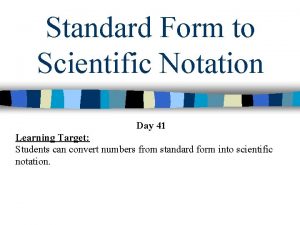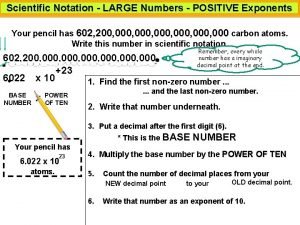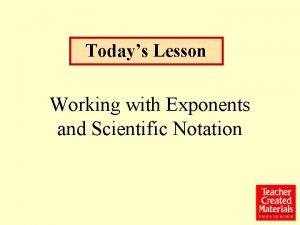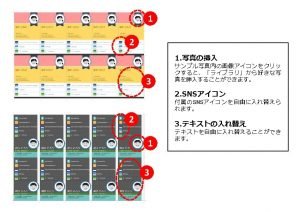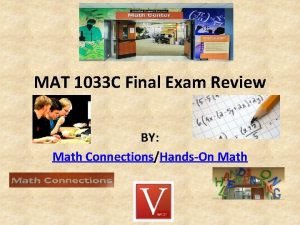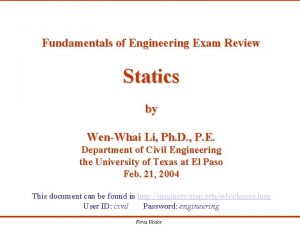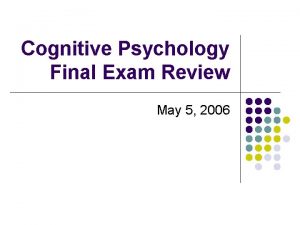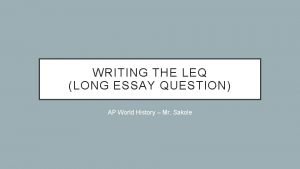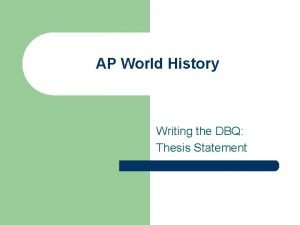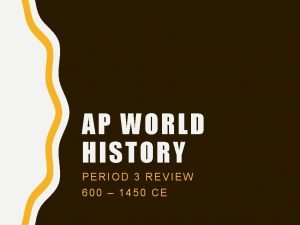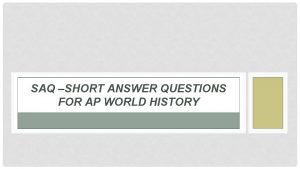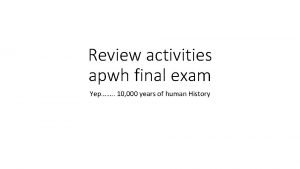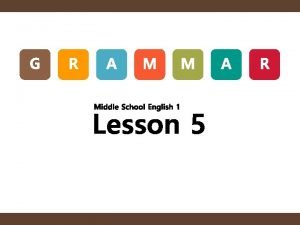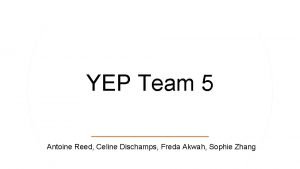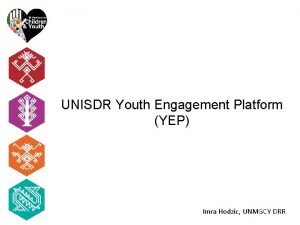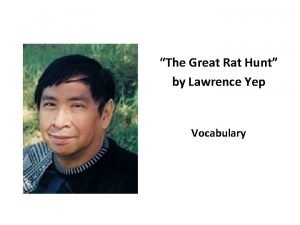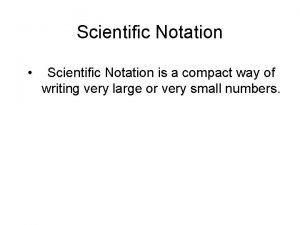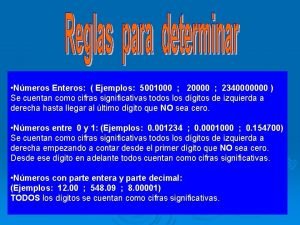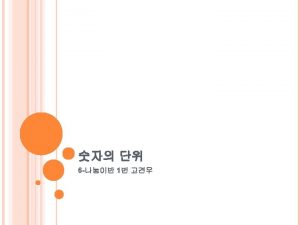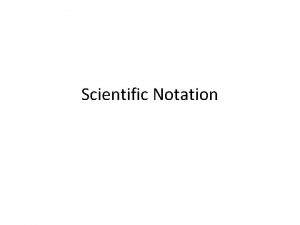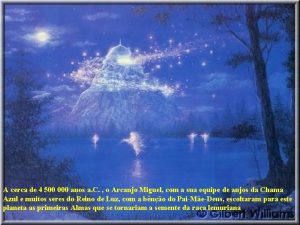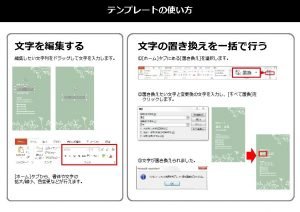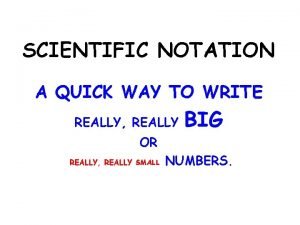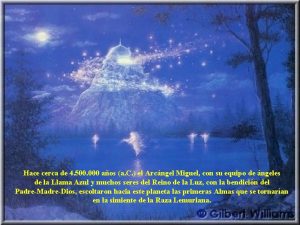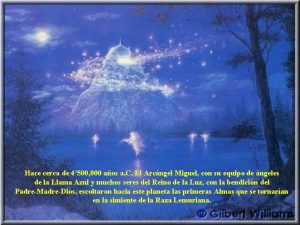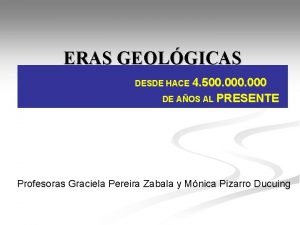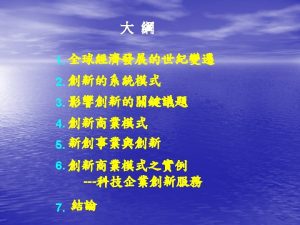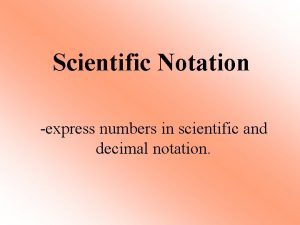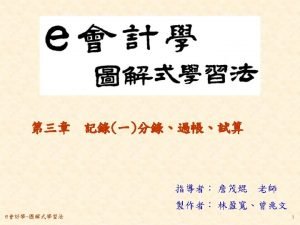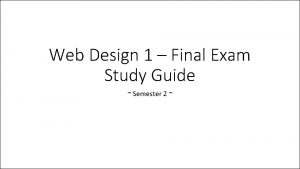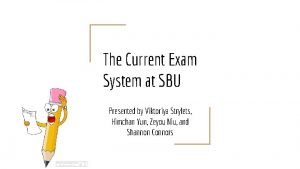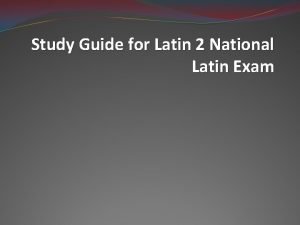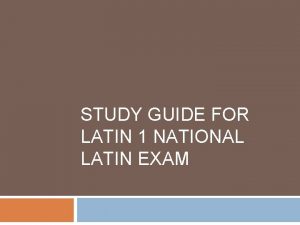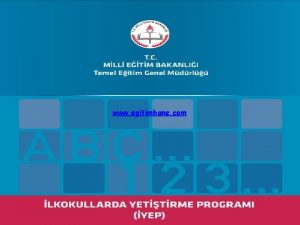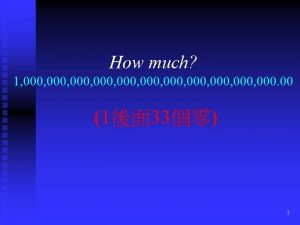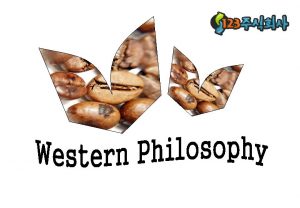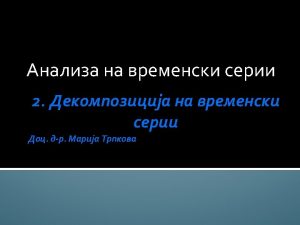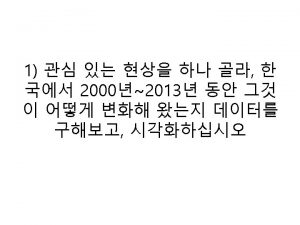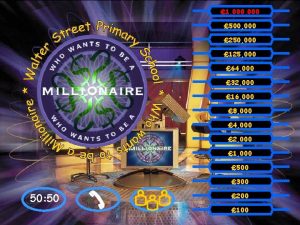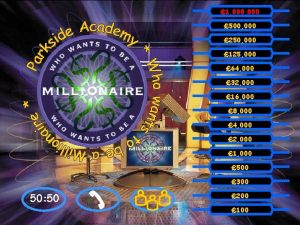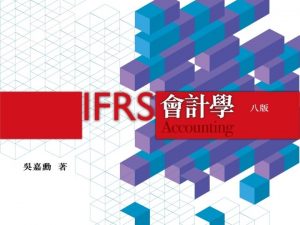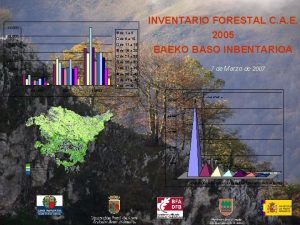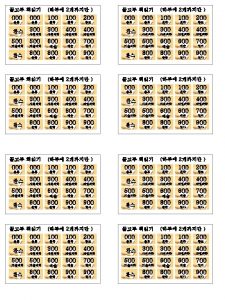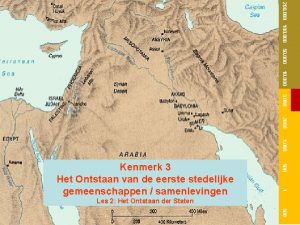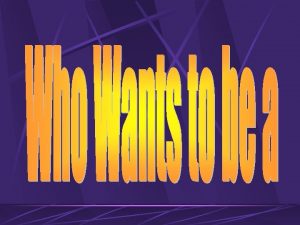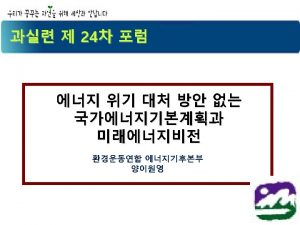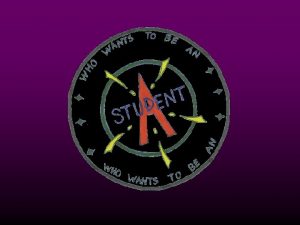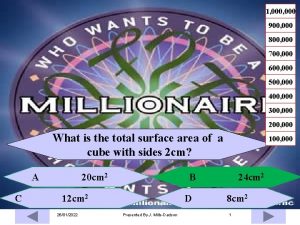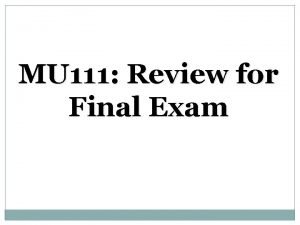Review activities apwh final exam Yep 10 000




































































- Slides: 68

Review activities apwh final exam Yep……. . 10, 000 years of human History

Remember Test Strategies! MC: 55 / 55 min Scan for topic/ time period before you read stuff. 1) When in doubt, match theme and era 2) Letter of the day and move on if you are unsure 3) They always go back to a key understanding or skill Short Answer 3 /50 min Choose 3 of the 4 Questions 1) NO thesis/ intro 2) Answer all parts 3) CONTEXT! WHY? Long Essay 40 minutes (suggested, you manage) Choice between 3 prompts 1) Big broad topic, YOU can find the evidence you know. Many examples will work. 2) Will be about one theme over time or big topics about change and continuity over time 3) Fully developed, THESIS, supporting evidence, context, synthesis DBQ: Document-Based Question 1 question, 15 pre-write and 45 writing minutes 1) KEY WORD—ARGUMENTATION!! LINE OF REASONING. 2) Quick note the docs, looking for pattern about author, opinon. 3) Group based on a common thread 4) Write: Intro Topic, Time period, thesis, paragraphs based on your groups. 5) POV x 3 6) Context: Why? Era trends and background of the time

Test section strategies: Multiple choice

Remember! You will not have seen the content on the MC portion NO FREAKING OUT! • Each image, passage, or chart is a summary or application or proof of one of our key understandings. SCAN ü Topic/ Region ü Time Period ü Theme CLARIFY ü Ask: What key understanding is this question addressing? ü Usually two options can be removed because they are factually untrue or unrelated to the time period/ topic. ü Warning: watch for options that are true, but don’t relate or answer the question. CHOOSE ü BEST answer, best guess.

Short Answer: Like MC but YOU come up with the answers. 40 minutes üYou answer the first two üThe last one you get to choose between two options üAnswer all parts, so if it asks you to explain one similarity and one difference, do both. üIf it asks you to evaluate or analyze, don’t leave that out! üWrite something no matter what. Don’t leave anything blank. üRemember, they are simply asking you about a key concept or a major fact under a key concept. --- Ask yourself, what key idea are they asking me to remember or prove? üAdd specific examples: nouns. People, empires, events, explain the causation, similarity, etc.

How to write for points

Short answer: 3 questions, 40 minutes, 3 points each 20% of score 1. No thesis! No intro! 2. Get to the point—use nouns, facts, events, empires. DON’t be general. 3. Answer all parts of the question 4. Make sure you explain “why” 5. There could be new terms, but they will be defined. ü Answer ALL parts of the question. ü Most of them ask you to explain WHY, Or “Analyze”. ü CONTEXT! Explain the larger trends or themes of the era.

DBQ Reminders: • It’s all about argumentation and line of reasoning. • It’s a half and half essay: Half what the documents prove and half your knowledge of history. Can you critically evaluate documents and evidence to form an argument or line of reasoning? Can you use “point of view” to be a critical consumer of historical documents and accounts? (source, author, tone, occasion, purpose, audience, context) 1. Stick to the verb key words of the prompt. 2. Argumentation and line of reasoning in your thesis (no general statements) 3. Use at least 6 documents 4. Use POV x 3 5. Bring in outside evidence 6. Explain Context (broader setting, era) 7. Do your topic sentences include the key words of prompt?

Long essay: 40 minutes you get to choose from a pair of questions 15% of score • will most likely deal with an entire era, probably identifying continuities or changes or a major theme, evaluation the impact of an event 1. Thesis shows argumentation 2. Evidence 3. Analysis (explain why, establish causation, etc. ) 4. Context: again…. What is happening in the world that influences these processes, events, people, chain of events)

Examples of long essay Evaluate the extent to which the emergence of Islam in the seventh century CE can be considered a turning point in world history. “In the period 1450 – 1750, oceanic voyages resulted in the Columbian exchange, which transformed the Eastern and Western Hemispheres. ” Develop an argument that evaluates how the Columbian Exchange affected peoples in Afro. Eurasia in this time period. “Different social, technological, and environmental factors led to the development of complex civilization in the period before 600 BCE” Develop an argument that evaluates how one or more factors led to the development of complex civilizations in this time period.

Scoring:

Self check üDon’t freak out: they are intended to be broad so you can pull from what YOU know. üFully communicate causation, similarities/ differences, evaluate (give a degree) üOrganize by main points. (One major similarity is…. . , Another similarity is……, however there were differences in …… üYour thesis and paragraphs should contain more specific words than the prompt. DON”T just restate the prompt. üThink of it as a typical 4 – 5 paragraph essay. Make 3 – 4 main points. Back them up with evidence, context, and your discussion of causation, change, impact, etc

Reviewing by era and topics

Era 1 1. 2. 3. 4. 5. 6. neolithic revolution Code of Hammurabi Specialization of labor Jewish diasporic communities Judaism assyrians Cuneiform Monotheism Patriarchy Sedentary Agriculture Bronze Chariots Indus River Valley Animism

Era 2 1. 2. 3. 4. 5. 6. 7. Roman Roads Twelve tables Dynastic cycle Han Civil service exams Ashoka Hellenism Christianity Merchants Phoenicians Mauryans Greek City-States Plato Aqueducts Plague

Era 3: 600 - 1450 Regional and Interregional interactions 1. 2. 3. 4. 5. 6. Silk road Mongols Islam Bedouin Trans-Saharan trade routes abbasids Umma Dhimmi Byzantines Justinian Constantinople Swahili Coast Mansa Musa

Era 4: 1450 – 1750 Global Interactions 1. 2. 3. 4. 5. 6. Mercantilism creoles Exports Astrolabe Columbian exchange Joint-stock companies Prince Henry Caravels Turks Ottoman empire Mughals Aurangzeb Scholar Gentry Zheng He

Era 5: 1750 – 1900 Industrialization and global integration 1) 2) 3) 4) 5) 6) Steam engine New forms of energy Social Darwinism Urbanization White Man’s Burden Imperialism Sepoy Rebellion Napoleon Enlightenment Declaration on the rights of man Toussaint L’Ouverature

Era 6: 1900 – present accelerating global change and realignments 1) 2) 3) 4) 5) 6) 7) United nations Green revolution Population Growth Vaccines and antibiotics Decolonization Gandhi electrification

people 1) 2) 3) 4) 5) 6) 7) Genghis khan Mansa musa Peter the great Mao Zedong Alexander the great King Hammurabi John locke

topics 1) 2) 3) 4) 5) 6) 7) 8) Forced labor Encomienda Mita Imperialism Plantation agriculture Civil service exam Grand canal Taj mahal

Religion 1) 2) 3) 4) 5) 6) 7) 8) Islam Polytheism Divine right Buddhism Reincarnation Vedas Confucianism Din-il-ilahi

Era 1: • What is the name of this era? • What is the most important event of the era? • Why? • What are the 5 most likely terms/ topics on the test? 1) Technological and Environmental Transformations 2) Agricultural Revolution and transition to Sedentary agriculture. 3) Because it causes further changes to society, government, and the environment. What are those changes? 4) Sedentary Agriculture, Origin and migration of first humans, code of Hammurabi, development of civilization, technology/ metallurgy,

What are they known for? 1) Mesopotamia (middle east) 2) China 3) India (Indus river valley) 4) Egypt/ Africa Mesopotamia: First civlizations Sumeria, Babylon, Assyria Warriors, conquerors of city-states King Hammurabi/ Code of Hammurabi– Law by social class Iron Age/ tools, dependent upon ag. City-state Cuneiform, ziggarut, flooding India: Indus River Valley Mohenjo-Daro Advanced Cities Pottery Undeciphered language polytheistic China: Most isolated Polytheism, ancestor worship Yellow River Valley/ Huang He Strong Patriarchy Mandate of Heaven Egypt: Centralized rule, pyramids, predictable flooding, polytheistic, divine kings, Nile River

Era 2: 600 BCE – 600 CE 1) What is the name of this era? 2) What is the greatest development during this time period? 3) Why? 4) How does this time period contribute to future time periods? 5) Where did these developments take place? What were the distinctive patterns of this time period?

Era 2: Organization and Reorganization of Societies 1. Organization and Reorganization of Societies 2. Classical forms of government and systems 3. These are the foundations and patterns established that will be followed or emulated even to this present day. Religious development is HUGE! 4. See above. 5. Mediterranean: Greece and Rome Big topics: Law China: Qin and Han Religion Africa: Egypt and Ethiopia Govt India: Mauryan and Gupta 1) What is the name of this era? 2) What is the greatest development during this time period? 3) Why? 4) How does this time period contribute to future time periods? 5) Where did these developments take place? What were the distinctive patterns of this time period?

Major regions/ topics Mediterranean Greece/ Rome Aristotle Greek City States, direct dem. Roman Republic Forum, senators, plebians, patricians, architecture, overexpansion, Roman Empire Christianity Start of Byzantine Plague Slavery, engineering (roads, aqueducts, dome/ columns, arches) Food handouts India: Mauryan/ Gupta City-states Vedas/ Sanskrit language Hinduism Caste system Trade Emergence of Buddhism Egypt Middle and new kingdom, axum, kush, • Regional trade • Ethiopia – Christianity • Continued centralized rule, conquered by roman empire towards the end China: Mandate of Heaven/ Dynastic Cycle Shi Huangdi: Qin/ centralization/ standardization, start of Great Wall Han Civil service exam, bureaucracy, Confucian values, luxury items Hellenism

Period 3 questions for discussion/ Review 1. How did the amount of trade change? 2. How did trade routes change? (What were they? ) WHY did they change? 3. What items were traded and what was the role of luxury goods? 4. What systems or actions did governments take to promote trade? 5. How did the expansion of empires affect trade and trade routes? 6. Which groups had technological advantages? (Technology to conduct long-distance trade? ) 7. How did nomadic people interact with civilizations, both good and bad. 8. What was the environmental impact of Bantu people? 9. How is the spread of Islam related to topic of trade? 10. What is a diasporic community and how does it relate to trade?

Period 3 questions for discussion/ Review 1. How did the amount of trade change? Intensification of trade. Not only more goods exchanged, but more routes, extension and expansion of routes 2. How did trade routes change? (What were they? ) WHY did they change? Trade routes were expanded. New regional routes emerge (trans-Saharan, Indian Ocean), Americas have new regional routes. Expansion of states leads to more routes. Also more technology at the very end of the period. 3. What items were traded and what was the role of luxury goods? food crops, luxury goods. Luxury goods the goal of all (textiles, porcelain, metals) 4. What systems or actions did governments take to promote trade? money or credit systems, passports 5. How did the expansion of empires affect trade and trade routes? Cause them to expand also and become more regulated 6. Which groups had technological advantages? (Technology to conduct long-distance trade? ) pastoralists 7. What was the environmental impact of Bantu people? 8. How is the spread of Islam related to topic of trade? Expansion of routes in Africa, trade instensifies spread of religion 9. What is a diasporic community and how does it relate to trade? Communities of people who live away from homeland. Jewish and Islamic diasporic communities live in Indian Ocean / Africa/ Mediterranean cities. Currency, printing money, banking systems, flying Spreading of agriculture, crops, and iron technology to S. Africa

More era 3 questions 10. Name all items that spread as a results of more intense trade 11. How did Muslim / Christian contacts transform Europe? 12. What new food crop was spread in Asia that impacted China? 13. As governments redevelop and re-emerge during the beginning part of the era, what did they keep from the previous era, and what did they change? 14. Name a handful of brand new empires 15. Describe the political and economic system of Europe at this time. 16. What technology did the Abbasids receive from contacts with China? 17. What technology did the Mongols (although they did not invent it) spread throughout Eurasia?

More era 3 questions 10. Name all items that spread as a results of more intense trade ideas, products, religion, cultural traditions, technology, knowledge 11. How did Muslim / Christian contacts transform Europe? Return of classical texts, math, astronomy of India and Middle East to Europe, better weapon technology 12. What new food crop was spread in Asia that impacted China? New varieties of rice 13. As governments redevelop and re-emerge during the beginning part of the era, what did they keep from the previous era, and what did they change? Continuities: patriarchy, centralized rule, religion, land-owning or religious elites, CHANGES: new taxation, tributary states, changing religion, 14. Name a handful of brand new empires Mongols, American Aztecs and Incas, Islamic Empires 15. Describe the political and economic system of Europe at this time. Feudalism: known HOW it works. 16. What technology did the Abbasids receive from contacts with China? Paper-making 17. What technology did the Mongols (although they did not invent it) spread throughout Eurasia? Gun powder, guns, eventually artillery

Era 3 Cont. 18. What was Neo-Confucianism and how did it impact China and Chinese social structures? 19. Name some agricultural innovations that increased productivity 20. Why did exporting increase? Which empires exported and what did they export? 21. Why did urban populations suffer during this time period? 22. How did urban life improve and why at the end of the period? 23. Entirely new concepts of labor emerged. Name a few new ones. What about labor systems remained the same? 24. Which societies allowed greater freedom and power during this period? 25. Name forced and semi-forced forms of labor. What is the danger of coerced labor?

Era 3 Cont. 18. What was Neo-Confucianism and how did it impact China and Chinese social structures? Backlash against Buddhism, return to more intense Confucian teachings, preservation of social order, gender roles, and scholar gentry 19. Name some agricultural innovations that increased productivity chinampas, terracing, horse collar plow (Europe) 20. Why did exporting increase? Which empires exported and what did they export? Government sponsorship of trade, increased demand. China, India 21. Why did urban populations suffer during this time period? Invasions, disease 22. How did urban life improve and why at the end of the period? Return of safety to trade routes, stronger governments, rise in temperatures leads to more food available 23. Entirely new concepts of labor emerged. Name a few new ones. What about labor systems remained the same? Craft production, guilds, govt labor taxes, 24. Which societies allowed greater freedom and power during this period? Mongols, West Africa 25. Name forced and semi-forced forms of labor. What is the danger of coerced labor? Serfdom, mita, corvee, Byzantines, = leads to revolts

Era 4 questions Review Main Topics

1. 2. 3. 4. 5. How did trade change? Name new technologies that made exploration possible What was the role of Portugal in maritime exploration? Significance of Christopher Columbus? What political and economic challenges led to increased desire for new trade routes? 6. What was the role of joint-stock companies? 7. What’s the big deal with silver? 8. What is the new economic system driving exploration? Name a few key tenets? Era 4

Era 4 1. How did trade change? In just about every way! GLOBAL circulation of goods, intensification of all routes, more prosperity to merchants, addition of Atlantic Trade Routes 2. Name new technologies that made exploration possible cartography, astrolabe, caravels, lateen sail, 3. What was the role of Portugal in maritime exploration? Prince Henry’s navigation school, first to make cartography improvements, knowledge of African coasts and routes to Asia, est. first posts 4. Significance of Christopher Columbus? Proves transoceanic exploration is possible, European discovery of Americas 5. What political and economic challenges led to increased desire for new trade routes? Rise of jointstock companies, European push for new routes of access to China, Ottoman Muslims tax trade and cut off trade, European empires want more direct and affordable trade with Asia 6. What was the role of joint-stock companies? Conduct trade goals of the state with personal profit, shared liability of losses. Become the “shippers” of the Asian trade routes, act as militias with local to establish ports of trade and control of local resources 7. What’s the big deal with silver? New global currency. Flowing to China and Europeans must find a way to stop the outflow of silver. 8. What is the new economic system driving exploration? Name a few key tenets? Mercantilism. Government control of the economy, focus on exports over imports and accumulation of silver.

Era 4 9. What were some of the social and cultural outcomes of the Atlantic Trading System? 10. What diseases were spread to the Americas in the Columbian Exchange? 11. Name a few foods that were introduced to Eurasia as a consequence of Columbian Exchange. 12. How did new foods/ crops impact demographic trends? 13. How did the global trading networks impact spread of religion? 14. What was the Little Ice Age? When was it? (years). Impact on farming? 15. What happened to peasant agriculture? 16. List and explain types of coerced labor by colonial government.

9. What were some of the social and cultural outcomes of the Atlantic Trading System? Migration, sometimes forced of people to Americas, spread of religion, NEW SOCIAL CLASSES BASED ON RACE in the Americas, reliance of European men on Native women for help with trade and governance 10. What diseases were spread to the Americas in the Columbian Exchange? Small pox, influenza, measles 11. Name a few foods that were introduced to Eurasia as a consequence of Columbian Exchange. Tomato, potato, sweet potato, corn, pumpkins, turkeys 12. How did new foods/ crops impact demographic trends? new food varieties increased life expectancy and allowed for population growth, even in the Americas over time, despite the great dying 13. How did the global trading networks impact spread of religion? Spread of new religions to the Americas as well as syncretic belief systems, (Christian + native American culture), 14. What was the Little Ice Age? When was it? (years). Impact on farming? Decrease in mean temperatures, late 1300 s – late 1800 s. Migration out of northern regions and adaption of new farming techniques 15. What happened to peasant agriculture? It remains, intensified, Russia is the worst, cotton in India 16. List and explain types of coerced labor by colonial government. Chattel slavery (slaves as property), indentured servitude, Encomiendas, Haciendas, Spanish adoption of Mi’ta Era 4

17. Who were some of the new political and economic elites? 18. How did family sizes change in Europe? 19. How did states use art to legitimize their rule? 20. How did states use religion to legitimize their rule? 21. How did states limit the power of minority groups? 22. How did states consolidate power? 23. Methods of imperial expansion? 24. Which empires are expanding greatly? 25. Which empires colonized the Americas? 26. Which empires colonized Asia? 27. What were common political weaknesses and challenges for states?

17. Who were some of the new political and economic elites? Manchus in China, Creoles in Spanish America, European merchants 18. How did family sizes change in Europe? smaller 19. How did states use art to legitimize their rule? Patronage of art to glorify rulers, public buildings such as churches, mosques (Taj Mahal), European palaces (Palace of Versailles) 20. How did states use religion to legitimize rule? Europe – divine right, Aztec practice of human sacrifice, Chinese emperor’s use of Confucian rituals, Safavid use of Islam 21. How did states limit the power of minority groups? By limiting full access to economic and political equality, basically discrimination (Think mestizo, mulatto, creole in Spanish America) 22. How did states consolidate power? Establish new trade ports, colonies, expansion, 23. Methods of imperial expansion? Gunpowder, armed trade, artillery and canons 24. Which empires are expanding greatly? Ottoman (at first), Safavid, Russia, Manchu (Qing), Mughal 25. Which empires colonized the Americas? Spain, Portugal, France, Britain 26. Which empires colonized Asia? Portugal, Netherlands (Dutch), Britain, 27. What were common political weaknesses and challenges for states? Piracy, religious tension (Europe: Protestant Reformation, Thirty Years War, Middle East: Ottoman / Safavid rivalry, uprisings and revolts of peasants, slaves, and lower classes, intense competition for resources, arrival of JS companies, loss of control of trade routes

Era 5: Industrialization and global integration. 1750 - 1900 1) What is industrialization and how was it an economic change? 2) How did industrialization change societies (social changes)? 3) How did industrialization shift political power in the world? 4) Name new inventions and machines of the industrial revolution 5) How did industrialization affect labor?

Era 5: Industrialization and global integration. 1750 - 1900 1) What is industrialization and how was it an economic change? It fundamentally changed how goods were produced and consumed, from a change from cottage industry and lower levels of production to manufacturing and mass production of goods. People worked in factories instead of in their own homes 1) How did industrialization change societies (social changes)? It created new social classes such as the middle class over the long run, tensions between proletariat and urban working poor and bourgeoisie, and did give women a greater economic role with the opportunity to earn wages in factories. 2) How did industrialization shift political power in the world? It further cemented the rise of Europe and other nations that chose or were capable of industrialization and led to the decline of nations that were delayed. It encouraged the development of imperialism and colonization as industrial powers sought new sources for raw natural resources and markets to sell goods. 3) Name new inventions and machines of the industrial revolution. Major changes included the invention of the steam engine and combustion engine, which relied on fossil fuels for energy. The First industrial revolution began in Britain and focused on textiles and transportation whereas the second surged in Germany, US, and Japan, and focused on machinery, chemicals, and war good. 4) How did industrialization affect labor? Labor changed. The factory system introduced the notion of hourly pay on an assembly line for wages. Labor unions grew out of the poor working conditions to advocate for better wages and conditions. Specialization of labor increased dramatically.

Era 5: Industrialization and global integration. 1750 - 1900 1) How did industrialization change the pattern of global trade? 2) What is an export economy and how was it used to benefit industrialized nations? 3) Expansion of global economy happened mostly for what empires? 4) How did industrialization lead to the colonization of people in the Americas and Asia?

Era 5: Industrialization and global integration. 1750 - 1900 1) How did industrialization change the pattern of global trade? More global and every region integrated through colonization and as industrial nations sought out natural resources 2) What is an export economy and how was it used to benefit industrialized nations? Economies that mass produce cash crops or extract natural resources to serve the mother country. Cash crops are cotton, tobacco, sugar, palm oil, metals, etc. )Profits are used to buy finished products. 3) Expansion of global economy happened mostly for what empires? Those that industrialized and profited from colonies, so mainly European, American, and later Japanese empires. 4) How did industrialization lead to the colonization of people in the Americas and Asia? Capitalists needed access to raw materials and cheap or forced labor and sought out other territories for those goals.

Era 5: Industrialization and global integration. 1750 1900 1) What is capitalism and its role in the new global economy? 2) What is a trans-national business and how did they grow out of global trade? 3) Name three major developments in trade infrastructure? 4) Describe different responses to global capitalism. 5) How did some states deal with negative social and economic effects of capitalism?

Era 5: Industrialization and global integration. 1750 1900 1) What is capitalism and its role in the new global economy? Capitalism is a new economic theory advocating for private ownership of businesses and unlimited profits. (Adam Smith, Wealth of Nations). It accepts economic inequality as a natural outcome. Laissez faire means government should not be active in managing business or economy. 2) What is a trans-national business and how did they grow out of global trade? conducted business in multiple countries and continents due to global nature of trade and the seeking of new markets. They 3) Name three major developments in trade infrastructure? Suez Canal in Egypt facilitated trade, Panama Canal made trade from Pacific to Atlantic shorter, (United Fruit Company, US and Central America) 4) Describe different responses to global capitalism. Rise of labor unions, socialist theory and communism, rebellions and revolts against elites, STATE-SPONSORED industrialization to stay competitive, (Egypt, Japan, tsarist Russia, Egypt), 5) How did some states deal with negative social and economic effects of capitalism? To prevent the rise of communism, they instituted reforms social as welfare, unemployment insurance, medical care, and pensions to give protections to low-income workers. (Germany) and expanded suffrage to ALL men and later women, added public education

Era 5: Industrialization and global integration. 1750 1900 1) How did the practice of imperialism lead to conflict? 2) Why and When did Africa fall to direct forms of colonization? 3) What is a settler society? 4) What is economic imperialism and how did it work?

Era 5: Industrialization and global integration. 1750 1900 1) How did the practice of imperialism lead to conflict? As nations are trying to compete economically, they are fighting over a fixed amount of land resources, so they are in conflict with eachother over territory and also in conflict at times with colonized people who resist outside rule. 2) Why and When did Africa fall to direct forms of colonization? In the late 1800 s, the race to colonize Africa began with the Berlin Conference and the staking of claims on the African continent leading to French control of West Africa, Belgium in Congo, and Britain in West Africa 3) What is a settler society? The US and Australia, in which European immigrants completely take over and form a new settling society in new territory. This is due to high rates of death due to disease and displacement of native populations. 4) What is economic imperialism and how did it work? To control another nation’s ports and economic policies but not rule it directly as a formal colony. Britain did this to China before, during, and after the Opium Wars.

Era 5: Industrialization and global integration. 1750 1900 1) How did new racial ideologies facilitate and justify imperialism? 2) Name two reasons for the massive wave of rebellion and revolution 1800 – 1900? 3) How did Enlightenment thinking lead to revolutions? 4) Name at least two revolution documents 5) What rights were people seeking in Enlightenment-based revolutions?

Era 5: Industrialization and global integration. 1750 1900 1) How did new racial ideologies facilitate and justify imperialism? Social Darwinism and White Man’s Burden emboldened European populations of the notion that they were a superior race and justified the domination and control of native people as morally o. k. 2) Name two reasons for the massive wave of rebellion and revolution 1800 – 1900? Resistance to absolutist and abusive governments and resistance to colonization 3) How did Enlightenment thinking lead to revolutions? Enlightenment caused people to question existing forms of government and to demand for individual rights including freedom of speech, separation of church and state, natural rights (John Locke), social contract theory and the right to rebel (Rousseau), voting rights (popular sovereignty), etc. 4) Name at least two revolution documents US Declaration of Independence, France Declaration of the Rights of Man, Simon Bolivar, S America, 5) What rights were people seeking in Enlightenment-based revolutions? Greater political and social equality (see principles of Enlightenment listed above)

Era 5: Industrialization and global integration. 1750 1900 1) What was unique about the Haitian revolution? 2) What is the special role of Creoles in Latin American colonies? 3) Give examples of native resistance and rebellion to colonization. 4) How did the women’s rights movement grow during this time period? Who were some major thinkers? 5) How did nationalism shape state formation?

Era 5: Industrialization and global integration. 1750 1900 1) What was unique about the Haitian revolution? It was a slave-led revolt and it was successful in establishing complete Independence. Led by Toussaint L’Ouverature. 2) What is the special role of Creoles in Latin American colonies? They were of Spanishdescent but born in the Americas and lacked as much access to high level jobs. They were educated and emboldened by Enlightenment ideals and often led rebellions and revolts 3) Give examples of native resistance and rebellion to colonization. Sepoy Rebellion in India resisted British treatment of Sepoy soldiers (unsuccessful), the Taiping rebellion pushed against the “foreign rulers” of the Manchu Qing dynasty, and the Boxer rebellion in China targeted British and other foreign officials who were indirectly controlling the failing Qing dynastic rulers. 4) How did the women’s rights movement grow during this time period? Who were some major thinkers? Women demanded equal political rights and the right to vote. 5) How did nationalism shape state formation? Nationalism shifted loyalties to intense pride and loyalty to one’s nation group, often defined by culture, ethnicity, and language. It led to unification of nations and sometimes to war.

Name that era!

Thinking about each era’s main events Era 1: up to 600 BCE Technological and Environmental Transformations Era 2: 600 BCE – 600 CE. Organization and Reorganization of Societies Era 3: 600 – 1450 Regional and Interregional Interactions Era 4: 1450 – 1750 Global Interactions Era 5: 1750 – 1900. Industrialization and Global Integration Era 6: 1900 – present. Accelerating Global Change and Realignments

Group 1: Place in the right era A. Rise of Christianity B. Neolithic revolution C. Rise of Buddhism D. Rise of Confucianism E. Foot binding, neo-Confucianism F. Rise of islam G. Development of monotheism, judaism

Group 1: Place in the right era A. Rise of Christianity B. Neolithic revolution C. Rise of Buddhism D. Rise of Confucianism E. Foot binding, neo-Confucianism F. Rise of islam G. Development of monotheism, judaism Era 1: Technological and Environmental Transformations B, G Era 2: Organization and Reorganization of Societies A, C, D Era 3: Regional and Interregional Interactions E, F Era 4: Global Interactions Era 5: Industrialization and Global Integration Era 6: Accelerating Global Change and Realignments

Group 2: empires A. Byzantine B. Rome C. Mughal D. Louis XIV E. Mongol F. Qing G. Han H. Gupta I. Abbasid Era 1: Technological and Environmental Transformations Era 2: Organization and Reorganization of Societies 600 BCE – 600 CE , B, G, H Era 3: 600 – 1450 CE Regional and Interregional Interactions A, E, I Era 4: Global Interactions 1450 - 1750 C, D Era 5: Industrialization and Global Integration 1750 - 1900 F Era 6: Accelerating Global Change and Realignments

Trade Era 1: Technological and Environmental Transformations transmitters. I A. Pastoralists emerge as key B. First globalization Era 2: Organization and Reorganization of C. Mercantilism Societies J D. Capitalism v. communism Era 3: Regional and Interregional Interactions A, F, G, K E. Joint stock companies Era 4: Global Interactions F. Dev. Of trans-Saharan routes B, C, E Era 5: Industrialization and Global Integration G. Columbian exchange H. Globalization, international corporations. Era 6: Accelerating Global Change and Realignments I. Clan to clan trade D, H J. Regional trade only K. Intensification on silk road

A. B. C. D. E. F. G. H. I. J. K. L. M. N. O. Chiang Kai-Shek Kublai Khan Marco Polo Mansa Musa Nelson Mandela James Watt Mary Wollstonecraft Woodrow Wilson Henry VIII Martin Luther Ashoka Akbar Muhammad Adam smith Napoleon people

A. Chiang Kai-Shek B. Kublai Khan C. Marco Polo D. Mansa Musa E. Nelson Mandela F. James Watt G. Mary Wollstonecraft H. Woodrow Wilson I. Henry VIII J. Martin Luther K. Ashoka L. Akbar M. Muhammad N. Adam smith Era 1: Technological and Environmental Transformations Era 2: Organization and Reorganization of Societies K Era 3: Regional and Interregional Interactions B, C, D, M Era 4: Global Interactions I, J, L Era 5: Industrialization and Global Integration F, G, N Era 6: Accelerating Global Change and Realignments A, E, H people

Religion review See your religion review chart for major faiths…. This is a review of some other stuff

Misc. religious topics • Sufi islam: emerging in the 1300 s, it is islam with an added layer of mysticism, which means personal devotion and intimacy with god. Sufis are an example of religious syncretism and transformation over time. They were instrumental in the spread of islam because they often worked as traders and merchants • Sikhism emerged in punjab region of india 1500 s (pakistan today), by GURU nanak, it is more of a blending of islamic notion of monotheism and supreme being with hindu flavor of personal devotion and access to god. It denies the human hierarchy to reach the divine being and emphasizes personal virtue. It is over simplistic to say it is a blending of hinduism and islam, but it incorporates and uses certain elements of both. Sikhs have been persecuted by other religions in the middle east.

Human Environment interaction 1. How have people used diverse tools and technologies to adapt to and affect the environment over time? 2. How and to what extent has human migration and settlement been influenced by the environment during different periods in world history? 3. How has the environment changed as a consequence of population growth and urbanization? 4. How have processes of industrialization and global integration been shaped by environmental factors and in turn how has their development affected the environment over time?

Cultural syncretism • What is it? Different than Cultural Diffusion, which is the spreading of a cultural element. Syncretism is the Blending of Cultural Elements.

Name this Four things…….

Name this Four things…….

Name this Four things…….

Revolutions….
 97 000 000 in scientific notation
97 000 000 in scientific notation Express 602200 in scientific notation.
Express 602200 in scientific notation. Apwh final exam review
Apwh final exam review 33 900 000 in scientific notation
33 900 000 in scientific notation Uncontrollable spending ap gov
Uncontrollable spending ap gov Apwh course and exam description
Apwh course and exam description 0,000 0,000 0,000
0,000 0,000 0,000 World history spring final exam review answers
World history spring final exam review answers Spanish final exam review packet answer key
Spanish final exam review packet answer key Human body systems final exam
Human body systems final exam Poe practice test answer key
Poe practice test answer key Ied final exam
Ied final exam World history b semester exam review practice
World history b semester exam review practice Entrepreneurship 1 final exam review
Entrepreneurship 1 final exam review Spanish 2 review packet
Spanish 2 review packet Environmental science defination
Environmental science defination American history semester 2 final exam
American history semester 2 final exam English semester 2 final exam
English semester 2 final exam Physics fall final exam review
Physics fall final exam review Noah carried a skateboard
Noah carried a skateboard Mat1033c
Mat1033c Fe exam statics
Fe exam statics Zoology semester 1 exam review answers
Zoology semester 1 exam review answers Earth science sol review
Earth science sol review Algebra 1 semester 2 final review
Algebra 1 semester 2 final review Hft 2401 exam 2
Hft 2401 exam 2 Personal finance final exam review
Personal finance final exam review Spanish 1 final exam
Spanish 1 final exam Psyc 1504 final exam
Psyc 1504 final exam Long essay question
Long essay question How to write a thesis ap world
How to write a thesis ap world 1450*3
1450*3 History short answer questions
History short answer questions Yep 10
Yep 10 Yep, she is who you think
Yep, she is who you think Caravel apwh
Caravel apwh Forum.it jobs
Forum.it jobs Celine
Celine Yep 10
Yep 10 The great rat hunt
The great rat hunt Www asuspromo.in
Www asuspromo.in Express 4,980,000, 000 in scientific notation
Express 4,980,000, 000 in scientific notation Scientific notation
Scientific notation 2,340,000,000
2,340,000,000 2340000000
2340000000 000 111 000
000 111 000 100 1000 1000000
100 1000 1000000 Scientific notation advantages
Scientific notation advantages 4 500 000
4 500 000 1-000-000-0000
1-000-000-0000 Milli kilo centi
Milli kilo centi 450 scientific notation
450 scientific notation Scientific notation rules
Scientific notation rules 1 600 000 000
1 600 000 000 1,000 x 3,000
1,000 x 3,000 Cancion lemuriana
Cancion lemuriana 4 500 000 000
4 500 000 000 4 500 000
4 500 000 260 000 000
260 000 000 What is 140 000 000 in scientific notation
What is 140 000 000 in scientific notation 1 200 000 000
1 200 000 000 60 000 000
60 000 000 4 000 000
4 000 000 World history final exam study guide
World history final exam study guide Web design final exam
Web design final exam American history final exam
American history final exam Sbu finals schedule
Sbu finals schedule National latin exam results
National latin exam results National latin exam answers
National latin exam answers
